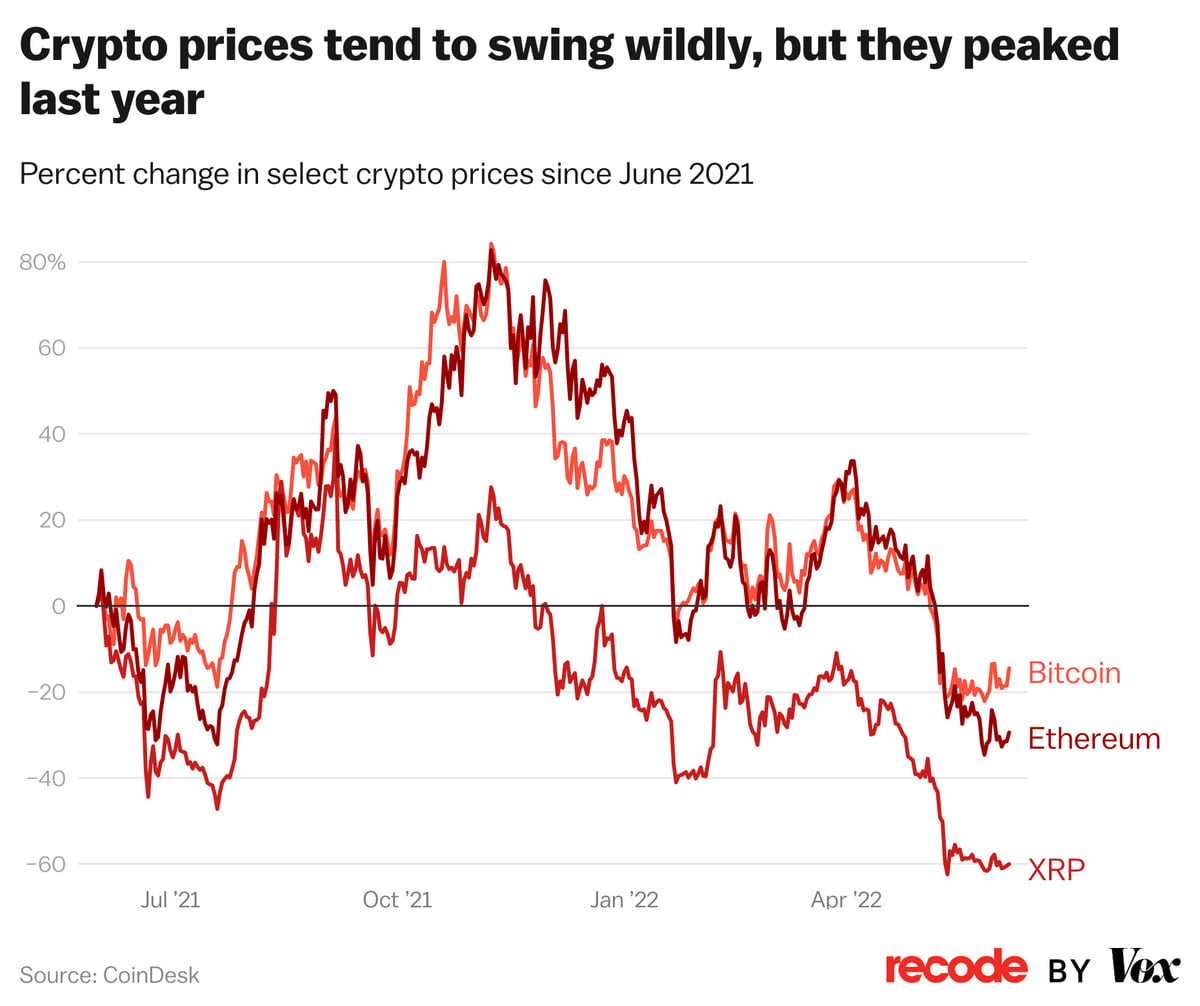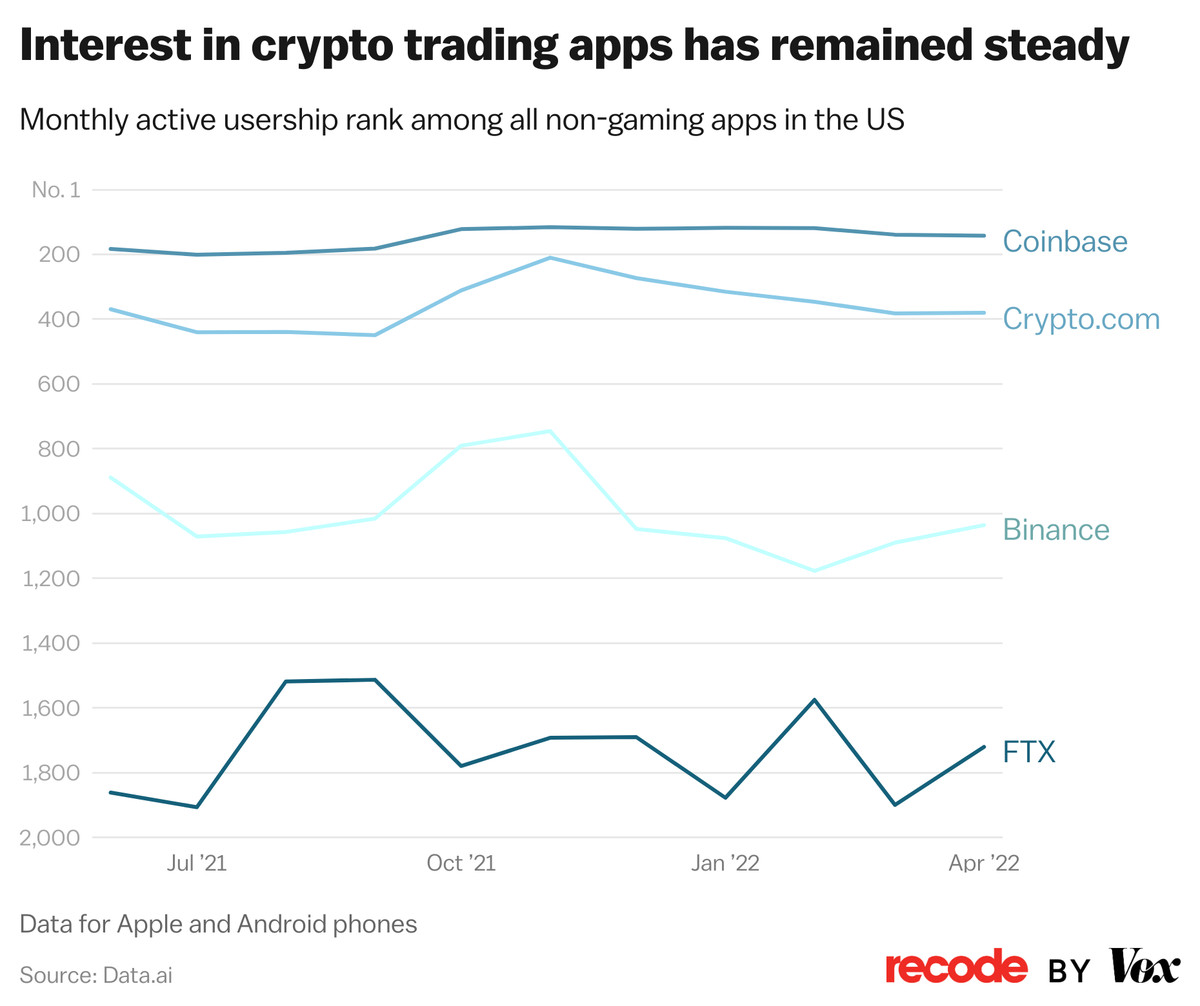You’ve seen this movie before. Or at least you know the plot: A new technology starts gathering attention, puzzling doubters but exciting its adherents, who promise that It Will Change Everything. A wave of hype and speculation lifts it into the public eye, culminating in Super Bowl ads that make the new tech seem thoroughly mainstream and enticing — if still confusing to most normals. Then, the crash.
So, yes. That was the first web bubble, back in the 1990s, which popped in March 2000.
It also seems like what’s happening to crypto and/or “Web3” — the recent rebranding of crypto — right now. Over the last year, your friends who don’t know anything about tech became aware of NFTs, even if they couldn’t explain them. The 122 million people who watched the Bengals-Rams Super Bowl in February also watched ads for formerly obscure crypto companies, like FTX, endorsed by a celebrity with no obvious connection to the product. Tag line: “Don’t miss out on crypto.”
And now the crash: Something like $1.5 trillion in value has disappeared since last fall as cryptocurrencies have plunged: Bitcoin is down 56 percent from its peak in November; ethereum is down about 63 percent. Don’t even ask about Dogecoin. Even the venture capitalists at Andreessen Horowitz, perhaps the most prominent crypto advocates in tech, concede that we may be entering a “crypto winter.”

The big question for everyone who has invested in crypto so far — institutional investors, startup founders and employees, and average folks who bought a bitcoin or a digital cartoon monkey — is whether Things Are Different this time. We don’t have an answer yet.
There are plenty of arguments on both sides. Here we should note that crypto bulls take pains to distinguish between blockchain, the technology based on a worldwide network of computers that talk to each other and record transactions, and cryptocurrencies, the assets often generated by that tech. In theory, interest in blockchain shouldn’t be tethered to the price of cryptocurrency; in reality, it very much is.
If you think crypto is plunging along with the rest of the stock market and the tech market specifically, you can point to data points like plummeting prices for NFTs. Or investment “down rounds” — private companies that are forced to raise money in deals that value their company at less than they were worth just months ago. That may be happening to BlockFi, a crypto trading platform. Less than a year ago, the company thought it was worth $5 billion; now investors are reportedly telling the company it’s worth $1 billion.
Or the fact that other crypto firms — including Coinbase, one of the crypto companies that splashed millions on a Super Bowl ad a few months ago — are doing hiring freezes or even layoffs.
Meanwhile, some workers who were eager to leave their Big Tech jobs for Web3 startups a few months ago may be having second thoughts. An executive at a privately held, non-crypto company tells me it has been much easier to recruit people from the likes of Google and Facebook than it was earlier this year when they were all heading to crypto.
There’s also a general vibe shift: A year ago, it was hard to find many tech people willing to spend time publicly critiquing crypto and Web3. Now there is an increasing number of them, from Box CEO Aaron Levie to software engineer Molly White, who runs a site dedicated to cataloging the travails and missteps of crypto and Web3 (I chatted with her recently on the Recode Media podcast.) See also: The glee in headlines like “Someone Stole Seth Green’s Bored Ape, Which Was Supposed to Star in His New Show.”
But if you think crypto isn’t going anywhere, you have your own data points: While Andreessen Horowitz is talking dark times in the near future, it also just raised a $4.5 billion fund explicitly earmarked for crypto investments. That money has to get spent somewhere, and there are still plenty of crypto investments happening: Katie Haun, a former federal prosecutor who became a crypto investor and raised a $1.5 billion fund earlier this year, just announced a new deal this week.
And yes, some people may be tired of cartoon apes. But that doesn’t mean they’re tired of NFTs. Something called Goblintown is the new hotness, people who spend time in this space tell me, as I nod knowingly even though I have no clue what they’re talking about.
Meanwhile Gary Vaynerchuk, the marketer/self-improvement guru who loves nothing more than the Next Big Thing, recently hosted a four-day VeeCon event on the floor of the Minnesota Vikings’ stadium in Minneapolis. The only way to get in was to buy a Vaynerchuk NFT, and he tells me that nearly 7,000 VeeFriends owners showed up.
And plenty of people I talk to in Web3 and crypto insist that things aren’t nearly as dire as they sound — and that they’re used to crypto prices swinging around wildly. It would be weird if they told me otherwise because they’re bought in. But it doesn’t mean they don’t believe it.
“This has been a cycle that’s been widely discussed as a crypto crash. But when you’re in it, it doesn’t feel like it,” says Jarrod Dicker, a tech entrepreneur and executive who’s now a crypto investor at the Chernin Group, an investment firm that specializes in media and tech. “I think a lot of these companies that are building or starting to build, they’ve raised their capital, they have their three- to five-year plan, and they’re going for it.”
For now, at least, crypto remains something plenty of regular people are interested in, for better or worse. Brandwatch, a company that does sentiment analysis of social media, says social mentions of “crypto,” “NFT,” and “Web3” have remained mostly positive for the last 12 months. Download rankings for crypto trading apps have also stayed pretty level, according to Data.ai.

But if we’re drawing parallels between now and the web 1.0 bubble, it’s important to note that it didn’t fully deflate overnight in March 2000 — it took a couple years for all of the dumbest dot-bombs to fade away.
I was around then, and I remember that you could measure the decline by the way successive waves of layoffs were treated: People who got dismissed by their dot-com early on got nice severance packages (I recall several people telling me they were going to spend their “funemployment” payouts on cooking school). But successive layoff rounds got less and less generous, and by the time the companies shut their doors for good, employees got nothing because there was nothing to give them.
So while I hate this hedge, I’m going to hedge: We’re not going to know how bad, and how meaningful, the crypto collapse is for some time. In the meantime, one of the things you hear from Web3 believers is that it wouldn’t be terrible for lame crypto companies to go away and leave the good ones intact. In this scenario, their company is Amazon, which survived the dot-com bust and became … Amazon; other people’s lame companies are theGlobe.com, a dot-com flagship that now exists solely as a Wikipedia entry.
“Every cycle, when there’s a huge bust, I think that the people who are quietly building are quite ecstatic because a lot of the noise is washed away,” says Tina He, the Web3 entrepreneur I talked to earlier this year when I was trying to get my head around the hype.
He is still building something called Station, which she hopes will be a LinkedIn for crypto workers, and says she has a “super lean” team of six workers and “plenty of runway.” On the other hand, she says, the fact that other Web3 teams might be struggling will impact her project, which assumes there will be plenty of Web3 projects and employees to track and connect with each other. So she can’t last forever without new cash.
“We’re actually quite optimistic and idealistic around our progress,” He tells me before acknowledging that she may need to raise a “bridge round” to get her through to a more forgiving funding climate. “Even without that, we could last through the winter — if the winter lasts less than two years.”
Rani Molla contributed to this story.





